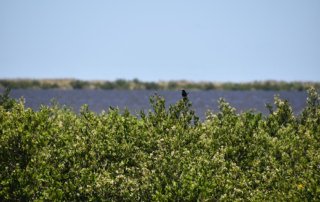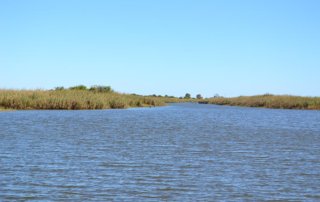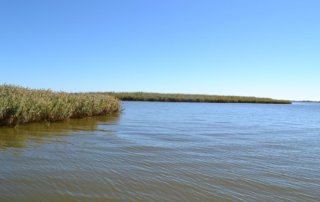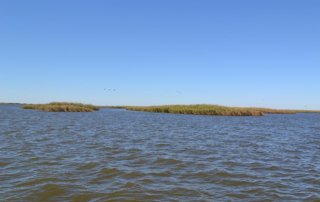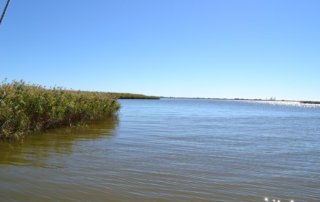 Marshes that extend for miles are found further south in the Barataria-Terrebonne Estuary.
Marshes that extend for miles are found further south in the Barataria-Terrebonne Estuary.
Marsh plant roots bind the soil, creating the fabric that holds the wetlands in place. Marshes also offer food and shelter to animals. Decomposed marsh plants are the foundation of this part of the estuary’s food chain. The food chain begins with the microorganisms that flourish on the decomposing plants. These microorganisms are a primary food source for many bottom- dwelling invertebrates that in turn provide food for small fish, shellfish, birds, and mammals. Marsh habitats can be divided into four zones that extend roughly parallel to the coastline: fresh marsh, intermediate marsh, brackish marsh, and salt marsh.
Fresh Marshes (salinities less than 2 ppt) are found mostly in northern marshes of Barataria-Terrebonne near Lake Penchant, Lake Theriot, Lac des Allemands, and Lake Salvador, as well as alongside the mouths of the Atchafalaya and Mississippi rivers. Of all Louisiana marshes, fresh marshes have the highest soil organic content and accommodate the most diverse array of plant life, including such species as maidencane, bulltongue, alligatorweed, giant cutgrass, waterlilies, irises, duckweed, pennyworts, pickerelweed, and spikesedge. Fresh marshes are important habitat for overwintering waterfowl. They also serve as important nursery habitat for the young of marine species such as seatrout, croaker, blackdrum, and flounder. Fresh marshes are home to a broad range of animals—such as frogs, turtles, ducks, alligators, muskrats, mink, otters, egrets, herons, and hawks.
Flotant Marshes are a type of marsh that can be found in either fresh or intermediate marshes. They are an unusual feature in Louisiana. Flotant marshes survive the sinking of the land by floating when water rises. This ability of the marsh to break away from the underlying sediment creates the mysterious “trembling prairies” or “flotants” that are found throughout Barataria-Terrebonne. The areas surrounding Lake Boeuf and Bayou Penchant exemplify floating marshes. Three-quarters of Barataria-Terrebonne’s fresh marshes are flotant. Some are so buoyant that they undulate when walked on; others are so firm it is difficult to tell that they are floating. Wildlife use the flotants frequently because they provide a “dry land” refuge in regions where flooding is frequent. In certain places, particularly thick flotant marsh can support woody plants such as wax myrtle and even small cypress trees.
Intermediate Marshes are found in areas where slightly salty water from irregular tides mixes with fresh water (salinities ranging from 2 to 8 ppt). Plants found in these marshes can tolerate infusions of slightly salty water and include the dominate marshhay cordgrass and widgeon grass as well as a mixture of bulltongue, spikesedge, three-cornered grass, common threesquare, giant bulrush, alligator weed, southern naiad, and deer pea. Depending on the season, waterfowl, wading birds, marsh hawks, and fur bearers are commonly found in these habitats. Intermediate marshes provide nursery habitat for brown shrimp, blue crab, gulf menhaden, and a variety of other commercially and recreationally valuable fishery resources. Intermediate marshes are located near Clovelly, Chauvin, south of Lake Salvador, and around Lake De Cade.
Brackish Marshes are irregularly tidally flooded by moderately salty water (average salinity 8 ppt) and vegetated by the dominate marshhay cordgrass as well as saltgrass, three-cornered grass, sturdy bulrush, seashore paspalum, widgeon grass, and many other plants. Barataria-Terrebonne’s brackish marshes stretch across the system in a band that includes Fourleague Bay, Galliano, Golden Meadow, and Little Lake. Louisiana’s fisheries rely on the productive vitality of brackish marshes. Blue crab, shrimp, speckled trout, and redfish flourish in brackish marshes as do muskrats, raccoons, mink, otters, and other mammals. Mottled duck, red-winged blackbird, common yellowthroat, least bittern, yellow-crowned night heron, and pied-billed grebes call this home.
Salt Marshes occur where salinity is highest (mean salinity of 16 ppt), in a band that stretches from the Gulf Coast, along the edges of Barataria and Terrebonne Bays, to north of Leeville and Cocodrie. The Gulf tides regularly flood salt marshes, creating conditions where salt-tolerant species dominate. Salt marshes are often totally dominated by smooth cordgrass, but other salt-tolerant species such as marshhay cordgrass, saltgrass, black needlerush, saltwort, and black mangrove can be found interspersed throughout. Many birds utilize this habitat including red-winged blackbird, seaside sparrow, marsh wren, clapper rail, reddish egret, white ibis, and brown pelican. The salt marsh acts as a nursery for larval forms of redfish, speckled trout, menhaden, crabs, and shrimp. After these species spawn offshore, larval and juvenile fish and shellfish move through the passes into the estuary where they feed and grow. The young tend to reside in shallow water along marsh edges for protection and access to food. As they mature, juvenile fish and shellfish move into deeper and more open water.


